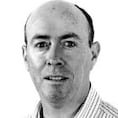Which Rory McIlroy will turn up at the US Open, starting at Torrey Pines on Thursday? The one who was a pale shadow of himself at the Masters, where he missed the cut? Or the one who was like his old self in winning the Wells Fargo at Quail Hollow? Or, perhaps, something in-between, like at the PGA Championship, where his work was done long before Phil Mickelson lifted the Wanamaker Trophy?
Former European Ryder Cup captain Paul McGinley, for one, who is extremely familiar with a golf course he describes as "a brute" going back to when it was effectively his local hangout in the Dubliner's days as a university student in San Diego, wouldn't put it past McIlroy to turn things around.
“When Rory gets that focus, he is like a horse with blinkers on. He’s gone! So we know it can turn around quickly with Rory and it is hard to discount him,” said McGinley. “ He can be very mediocre at times, very frustrating to watch at times. But we know he can switch very quickly.
"I would say there is still a bit of bedding down going on with Pete Cowen. He's changing his ball flight with the driver, going from right-to-left to more of being a fader of the ball and his driving statistics have not been as stellar. If he can start getting control of that driver and that small control fade he's looking for.
"The work he's done with Brad Faxon on his putting, there's real good steadiness. His short game's in good shape. If he can get his driving right. Where he is on that journey with Pete Cowen, only they can answer that.
“Looking from the outside, we haven’t seen him dominate tee-to-green like he normally does when he wins tournaments. We have got to give that relationship time . . . I wouldn’t discount him this week, he has decent form around here. This is a test that would generally suit him, this long wet [course] and heavy air. This is a test that can suit Rory if he finds a bit of form.”
McIlroy’s last of four Major wins came in the PGA in 2014 and the drought has gone on longer than anyone could have envisaged, not least the player himself.
"Rory's got to deal with pressure and expectation. Outside of Tiger Woods, he is probably the number one guy who garners the most attention, the most recognised player in the game and a lot of attention and a lot of question marks. Particularly internally from himself, 'Why aren't you winning? Why aren't you winning?' And that brings a lot of expectations. It's something you have to overcome, it's not going to go away, you have to have a strategy," he observed.
McGinley – who arrived in San Diego last week where he will be part of the Sky Sports commentary team at the season’s third Major – is also hoping that the USGA turn a deaf ear to any whining or moaning about the heavy rough on the South Course, where the kikuyu grass makes it especially difficult for players to execute recovery shots.
“The set up at the US Open has always been very narrow fairways. As [Lee] Trevino used to say, ‘Walk in single file down the fairways!’ It has always been that test and I hated to see Erin Hills and places like that where the USGA overreacted to criticism by making the golf courses too easy. A US Open should be a mental test as well as a physical one.
“The rough in a US Open should always be longer and tougher than in any tournament the players play in. That is the exam. That is the DNA of what a US Open is and I hate to see them moving away from that.
“They have this kikuyu grass grow, it is a lot thicker and deeper than back in January [at the Farmers Insurance Open] and I’m hoping it is going to stay that way, that they don’t react to players in practice rounds saying they can’t move it and cut it down which they have done in the past. It is having a bit of balls and sticking to the DNA of a US Open.”



















